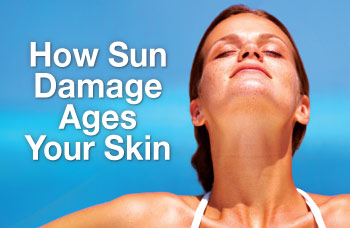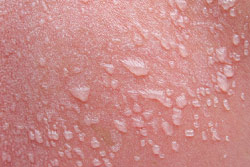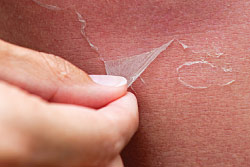How Sun Damage Ages Your Skin
Warning Signs Of Too Much Exposure Tips For Prevention And Treatment

Awareness of the sun's power to harm skin has made a constantly cultivated suntan less desirable than it used to be. However, even if your sun-worshipping days are long over, you may notice that the older you get, the more brown marks and darker patches you have on your skin. What you are seeing is the effect of your prior sun exposure. And the most constantly exposed skin you have is on your face. It's important to keep an eye on these changes — they may be cause for concern.
Sun exposure is the major cause of damage to your skin. In the short term, too much sun will cause a burn, sunburn, and in the longer term, chronic exposure to the sun will cause photo-aging (“photo” – sunlight; “aging” – deterioration).
Basically, the more sun exposure you get, the more damage your skin will sustain. And some skin types do worse than others, for example, thin skin versus thicker skin types, fairer types versus darker types. Sun damage is cumulative and begins at an early age. Skin changes in response to sun damage determine the onset and extent of photo-aging; its effects may appear as long as 20 to 30 years after sun damage first occurs. It is not uncommon to see signs of early to moderate photo-aging (brown spots, dryness, wrinkles) in your 40's — even if you used sunscreen in recent years.
How to Treat Sunburn
Is a suntan protective against sunburn or skin damage? NO — A tan is evidence that you already have sun damage, whether you realize it or not! Sorry — Myth busted!
 |
| An example of sun burning of the facial skin. |
 |
| Several hours after sun burn, fluid filled blisters can appear on the skin surface. |
 |
| The damaged skin from sun burn peels off. |
Skin damage starts with exposure to the sun's ultraviolet (UV) radiation. Even though you use sunscreen, you can still burn. Most people have experienced sunburn; within a few hours of sun exposure the skin becomes red, itchy, even painful and hot to the touch. Intense sun exposure results in sunburn increasing your risk of skin diseases and complications.
If you do get sunburn, several home remedies and treatments can relieve the discomfort and speed the healing of your skin. However, even effective sunburn treatment only helps ease the symptoms:
- Keep sunburned areas cool: Apply cold compresses dampened with cool water or take a cool bath.
- Keep the affected areas moist: Apply aloe or moisturizing cream to the affected skin. Avoid products containing alcohol, which dry out skin.
- If your skin blisters: Leave blisters intact, don't burst them, it will slow healing and increase the risk of infection. Cooling compresses soaked in milk are helpful. If blisters burst, blister adhesives or wound dressings from your local pharmacy or drugstore may be helpful.
- Take non-steroidal anti-inflammatory medication: If needed, take anti-inflammatory medication — such as aspirin or ibuprofen. This will help control discomfort and swelling. Avoid aspirin for children or teenagers — it may cause Reye's syndrome, a rare but potentially fatal disease.
- If your skin peels: This is the sloughing of the top layer of damaged skin. While your skin is peeling, continue to use moisturizing cream.

